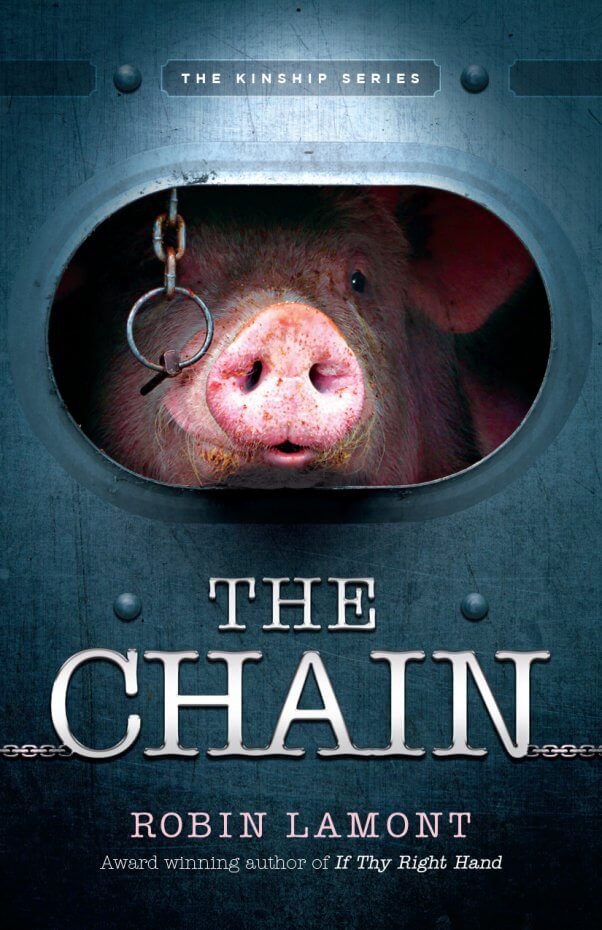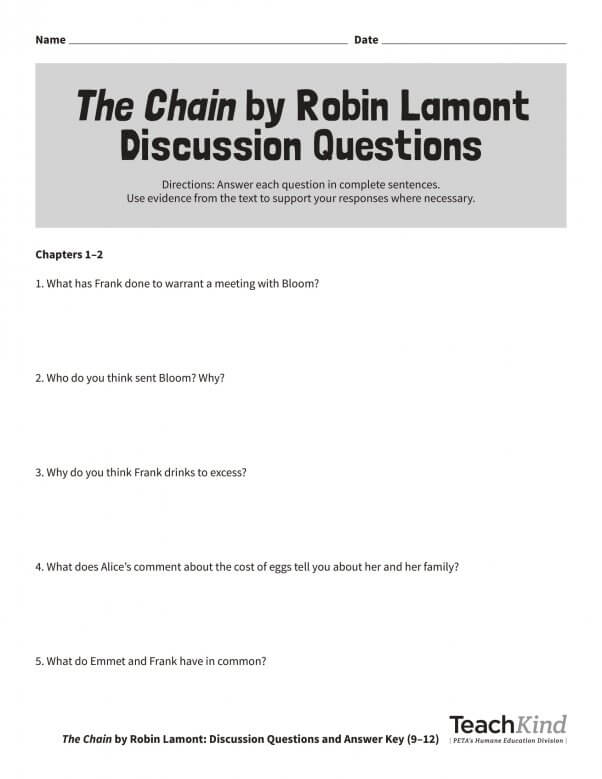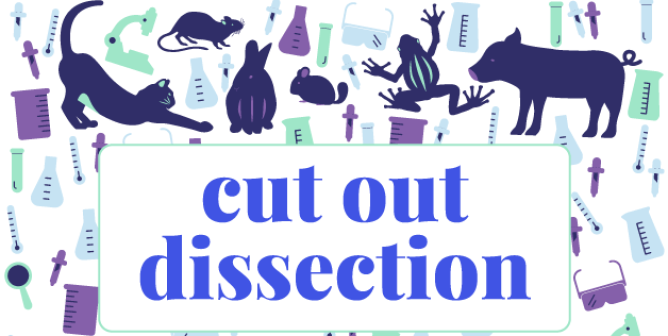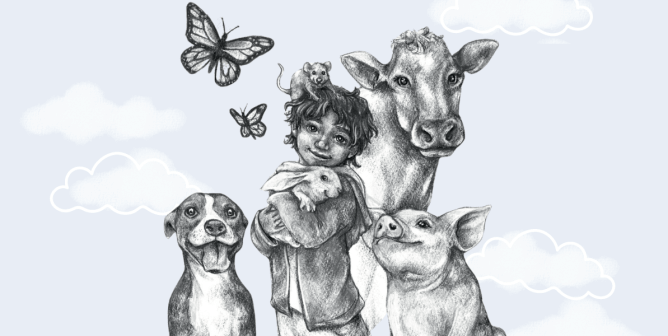Novel Study: Robin Lamont’s ‘The Chain’ From The Kinship Series
As a former English teacher, I can attest to how challenging it can be to get students excited about reading. It takes an exceptional story with exciting characters and high stakes to compete with TikTok, Instagram, and Snapchat in the minds of young people—and The Chain by award-winning suspense novelist Robin Lamont is one of them.
Just read this teaser:
Jude has been summoned to Bragg Falls to meet with a whistleblower who has documented the dangerous conditions for workers and the cruel treatment of pigs about to be slaughtered at D&M Processing. But when she arrives, she finds that her contact has committed suicide and the video he made is gone. The deeper she probes, the more the town’s residents turn against her—afraid that an exposé will shut down the plant. But beyond the local resistance, there is a more sinister force that will do anything to hide what is happening behind the closed doors of the slaughterhouse.
This page-turner has everything necessary to engage even the most reluctant readers, from gripping mystery and breathtaking action to forbidden romance and a look inside two seemingly opposing worlds seldom seen by most: the world of an undercover animal rights investigator and that of slaughterhouse workers and their families. Bryan Monell of Farm Animal Rights Movement (FARM) writes, “Do yourself and the animals a favor. Read this book.”
Use the following activities to supplement students’ reading of the text and to meet these Common Core Learning Standards for Reading Literature in grades 9–12:
- CCSS.ELA-.RL.9-10.1 Cite strong and thorough textual evidence to support analysis of what the text says explicitly as well as inferences drawn from the text.
- CCSS.ELA-.RL.9-10.3 Analyze how complex characters (e.g., those with multiple or conflicting motivations) develop over the course of a text, interact with other characters, and advance the plot or develop the theme.
- CCSS.ELA-.RL.11-12.1 Cite strong and thorough textual evidence to support analysis of what the text says explicitly as well as inferences drawn from the text, including determining where the text leaves matters uncertain.
- CCSS.ELA-.RL.11-12.3 Analyze the impact of the author’s choices regarding how to develop and relate elements of a story or drama (e.g., where a story is set, how the action is ordered, how the characters are introduced and developed).
Before Reading
Introduce students to author Robin Lamont by having them read this page on her website. Explain to them that The Chain is the first of the three novels in The Kinship Series. Have them discuss the following questions:
- At what age did Lamont start writing? What did she write? (Answer: She was 11 years old when she started writing. She wrote a newspaper for her family.)
- What other jobs has Lamont had? (Answer: She was a Broadway actor/singer, a private investigator, and a prosecutor [lawyer].)
- What inspired Lamont to write The Kinship Series? (Answer: Her growing awareness of animals and their “amazing survival skills, intricate communication, and the emotional bond they form with humans and with each other” inspired her to write it.)
Next, provide students with some background on the novel that they’re about to read. Inform them that it’s set in a rural town whose residents depend on a pig slaughterhouse for their livelihood. Explain that the novel not only sheds light on the cruelty endured by pigs raised for food but also reveals the exploitation of slaughterhouse workers by the animal agriculture industry. Have students read the article “Confessions of a Slaughterhouse Worker,” which details the toll that killing animals for a living can take on a person’s mental well-being, and discuss the following questions (after pointing out that in the U.K., slaughterhouses are also called “abattoirs”):
- Identify a physical hazard that slaughterhouse workers faced at this particular facility. (Answer: The author writes, “There were countless occasions when, despite following all of the procedures for stunning, slaughterers would get kicked by a massive, spasming cow as they hoisted it up to the machine for slaughter.”)
- The author admits that she became skilled at disassociating (viewing cows as “saleable, edible body parts” rather than as individuals) while working at the slaughterhouse. Why does she say that this was necessary? What made it impossible for her to continue thinking this way? (Answer: She says that disassociating not only allowed her to do her job with more ease but also kept her alive. She admits that she experienced suicidal thoughts while working at the slaughterhouse and that disassociating helped her cope with these feelings. Whenever she walked past a large dumpster filled with the heads of hundreds of cows, their eyes still intact, she was forced to reckon with the fact that they once belonged to living, feeling beings whom she had a hand in killing.)
- The author describes the slaughterhouse workers as “hard men.” What two incidents in particular revealed that they were also struggling internally? (Answer: When one worker cut into the gut of a cow, revealing that she was pregnant, he began throwing his arms around and repeatedly shouting, “It’s just not right.” When the author tried to calm him down, she could see tears in his eyes. On another occasion, when five calves had to be slaughtered at the same time in order to control the spread of disease, the workers were visibly upset.)
- In addition to alcohol, what other substance did some of the workers abuse? Why? (Answer: Some of them became addicted to energy drinks—which usually contain a lot of caffeine—because they were working second jobs after their 10- or 11-hour shifts at the slaughterhouse. Note to teachers: It might be helpful to point out that, according to the author, “more than one had a heart attack” as a result of their energy drink addiction.)
- Why did the author feel that she couldn’t talk to people about her work and the struggles that she was facing? What impact did this have on her mental health? (Answer: When she told people what she did for a living, they were either repulsed or made jokes about it. She eventually stopped opening up to people about it, which made her feel more isolated and helpless.)
- Why do you think the worker who joked about “not being here in six months” begged the author not to tell their bosses that he was suicidal? (Possible answer: He was probably afraid of losing his job, and the fact that he was working at a slaughterhouse in the first place likely meant that he didn’t have many, if any, other options.)
- In response to the Tideford slaughterhouse worker’s quote, do you think someone can be an “animal lover” and still eat animals? (Answers will vary depending on students’ experience. Encourage them to consider how they responded to the author’s anecdotes about the cows slaughtered at her facility. Ask them to speculate about their reasons for feeling that way and how they can better align their feelings about killing animals with their actions.)
- According to the British Meat Processors Association, “Most people, while they eat meat, find it difficult to work in its production partly because of the obvious aversion to the slaughter process but also because it is a physically demanding role.” Do you think people who eat meat should be willing to participate in, or at least witness, the slaughtering of the animals? Why or why not? (Answers will vary depending on students’ experience. Here’s another question you could pose: Is it fair to pay someone else to kill animals for you? Why or why not? Encourage students to reflect on the treatment of the slaughterhouse workers discussed in the article and consider whether the cruelty to animals and the exploitation of the workers is a fair price for the opportunity to eat meat.)
You may wish to extend this warm-up activity into a full lesson on the psychological phenomenon known as cognitive dissonance and “the meat paradox.” While a lesson about this can be uncomfortable, it can be used very effectively in the classroom to help students reflect on, understand, and change their own beliefs and behavior. Studies show that the experience of cognitive dissonance can be used to foster prosocial behavior and promote change.
Cognitive Dissonance and How We Treat Animals (Grades 6-12)
During Reading
Have students respond to the following discussion questions as they read. Review answers as a class before moving on to the next section.
Download the discussion questions.
Download the answer key.
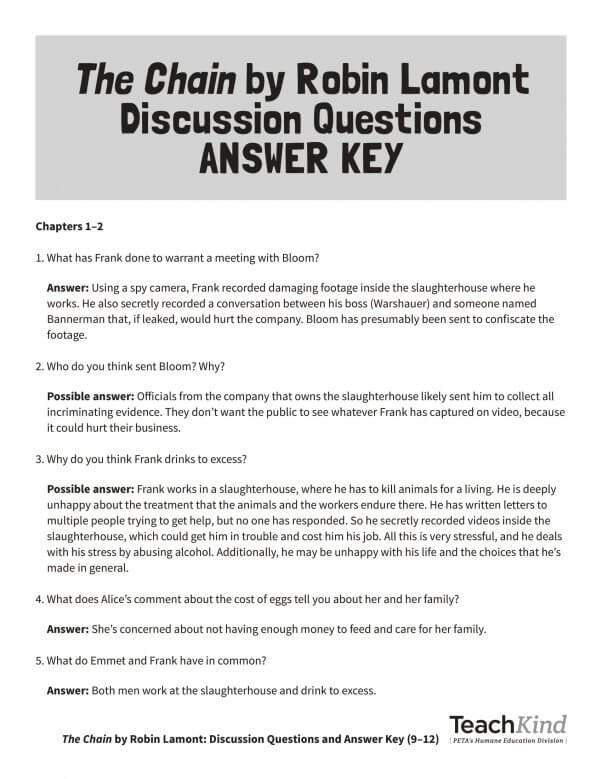
After Reading
Have students choose one of the main characters (such as Jude, Emmett, or Caroline) to analyze. Explain that just as we can tell a lot about real people based on their words, opinions, behavior, and appearance, we can use these same indicators to judge characters in stories. Through giving them different traits, authors create characters who are likeable, villainous, or a complex mixture of both. It’s part of what makes stories like The Chain interesting.
Have students write their chosen character’s name at the top of a blank piece of paper and create two columns by drawing a vertical line down both the front and the back of the page. Label the left column “Examples from the text” and the right column “What does this reveal about the character?” Next, divide the columns into three equal rows on the front of the page and two on the back, forming a table with six spaces on the front and four on the back (not including the column labels). Finally, label each row with the following categories:
- Spoken words (what the character says)
- Inner thoughts (what the character thinks)
- Actions (what the character does)
- Appearance (what the character looks like)
- Others’ opinions (what others say or think about the character)
When they’re done, students should have a graphic organizer that looks like this:
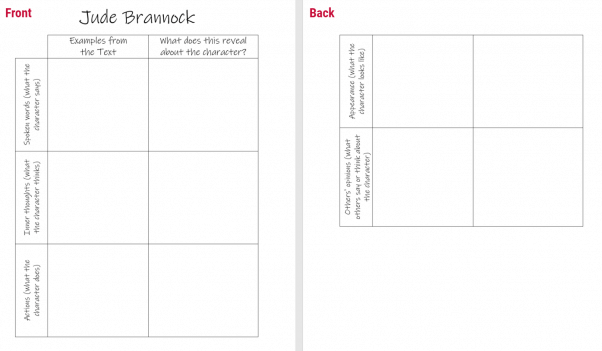
Ask students to review their responses to the discussion questions as well as the text to fill in their character analysis graphic organizers, quoting examples from the novel and explaining their significance in the appropriate columns. It may be helpful to discuss each characterizing trait category (for example, the character’s appearance can be determined by finding descriptions of their clothes, hairstyle, etc., in the text). You can also provide students with examples in each category, pointing out that under the “What does this reveal about the character?” column, they should use adjectives to describe their character’s personality (bolded in the following examples). Here are some examples for the character Frank Marino (who should be excluded from student analysis because he’s a minor character):
- Spoken words (what the character says): When Bloom asks Frank if he has any questions, he responds, “No one goes near my wife and daughter, right?” He goes on to say, “If anything happens to either of them, I’ll kill you.” This reveals that he is protective of his family.
- Inner thoughts (what the character thinks): The author reveals that when Frank recorded the secret footage inside the slaughterhouse, he was thinking of his wife and daughter. He thought, “They deserved a better husband—a man who had principles.” This indicates that he is an honorable man who is willing to put his life in danger to fight for truth and justice.
- Actions (what the character does): Frank spent years bringing his concerns about the treatment of the pigs and the working conditions for employees at D&M to management, the USDA, OSHA, and the State Attorney General’s Office before he decided to record the footage. This determination reveals that he’s committed to helping others and improving conditions at the plant.
- Appearance (what the character looks like): Frank describes himself as “stubby …, the way he remembered his Italian grandfather,” indicating that he is a modest man who doesn’t think highly of himself physically.
- Others’ opinions (what others say or think about the character): Frank’s wife takes a “dim view of [his drinking] habit, accusing him of having emergencies every day based on the number of empty bottles she found in the trash.” This reveals that he has a drinking problem, likely from being stressed about the conditions at the plant.
Finish by having students practice writing thesis statements for an analysis that they could write about their character using the adjectives that they came up with. For example, this might be an appropriate thesis statement for an analysis of Frank: “Even though he’s a protective husband and father, Frank’s honor and commitment to helping others—regardless of their species—costs him his mental health and ultimately his life.” You could then have students write an essay arguing their claim or respond to one of the following writing prompts:
- Some people argue that the risk of injury (both physical and mental) is just part of working at a slaughterhouse and that workers’ compensation and other benefits are available for those who do sustain injuries on the job. Others argue that slaughterhouse workers shouldn’t have to risk personal injury or even death to produce meat at a low cost to consumers. What are your thoughts on this issue? Explain your answer fully.
- Marshfield suggests that it’s unfair of animal rights organizations like The Kinship to target his company while others like it are mistreating animals the same way. Assess this way of thinking. Is it ethical to do something immoral just because “everyone else is doing it”? Do you sympathize with Marshfield when it comes to his dedication to consumers’ demand for affordable food? Explain your answer fully.
Extension
Students have an exciting opportunity to chat with Robin Lamont, author of The Chain. After they’ve read the novel and completed the activities above, have them prepare questions for Lamont—these can be about the novel, authorship, animal rights, or whatever else students are interested in learning. Then, send her an e-mail to set up an interview. Because her staff is limited, she may have to answer your questions via e-mail, but in some cases, she may be able to chat via Skype.
Additional Resources
- Chapter 1 of The Chain is available online.
- The Trap and The Experiment, the other books in The Kinship Series, are available to order online.
Tell us how you plan to integrate this lesson into your curriculum and you could receive a free PDF copy of the book!

